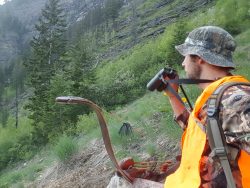Spring bear season in Montana can be both tough and rewarding. Spending hours glassing hillsides only to find a couple mule deer does and chirping rock chucks isn’t very motivating as I’ve learned through experiemce. It took a while to learn how, when and where to locate bears in Western Montana even after asking successful hunters I still couldn’t seem to find bears consistently.
Snowline
I’ve probably heard this word used more times than I can remember. “Bears follow the snowline in spring looking for fresh grass shoots”. Ok, I got it. Look for snow. But really the places where there is snow immediately accompanied by good bear feed is limited. More often than not, the snow is far removed from grass although if you can find the spot where snow meets good green grass in early May and it’s accessible (practical and safe) then you have hit the jack pot – maybe.

After glassing prime looking hillsides for days I’m convinced that not all prime looking hillsides were created equal.
WATER
Any good bear baiter in states where it’s legal knows that even the best baits will fail if they aren’t near water. Once I started looking for green shoots with an obvious stream of water running through the middle of it I started finding bears. That doesn’t mean that they were accessible but I still found them. Key in on water – without it your odds of finding a bear go way down.
PERSISTENCE
No one wants to hear more crap about putting more time in to find more bears. While there is some undeniable statistical evidence to support that statement the reality is that if you just look up a drainage for five minutes and move on you’re probably missing bears. My friend and I just spent an hour glassing an open hillside with a green shoot below a snow covered mountain before walking up the trail to look at more areas. On our way back I looked up there again and found a black bear which we looked at as it walked across the slope. Within 2 minutes it disappeared. The persistence required is more about glassing the right spot and settling in for the amount of time needed to find tbe bear that’s there. This doesn’t mean to run all over the mountains glassing as many areas as possible in a day. It’s a game of quality over quantity.
RIGHT TIME
Bears are found from first light until about 11:00 am. Then again during tbe last couple hours before dark. If you find a bear at 10:30 am it’s probably better to wait until late afternoon to get into position near the feeding area than it is to charge up the mountain. For two reasons. One: the thermals are moving up in the morning so unless you can get above the bear quickly, wait. Two: The bear is probably getting ready to take an afternoon nap at that point in the day. Trying to sneak up on a sleeping bear can be much more difficult than sneaking up on one that’s distracted by food.
Finding bears seems to be one of those skills that some hunters possess and others don’t. There isn’tva whole lot of mediocre bear hunters. I think it’s because once you get it you’ve got it. One thing is for sure, sitting at home won’t help you find brars. Don’t get discouraged. Look for bears but enjoy those hummingbirds, grouse and mule deer as you become one of the bear hunters that get it on purpose.